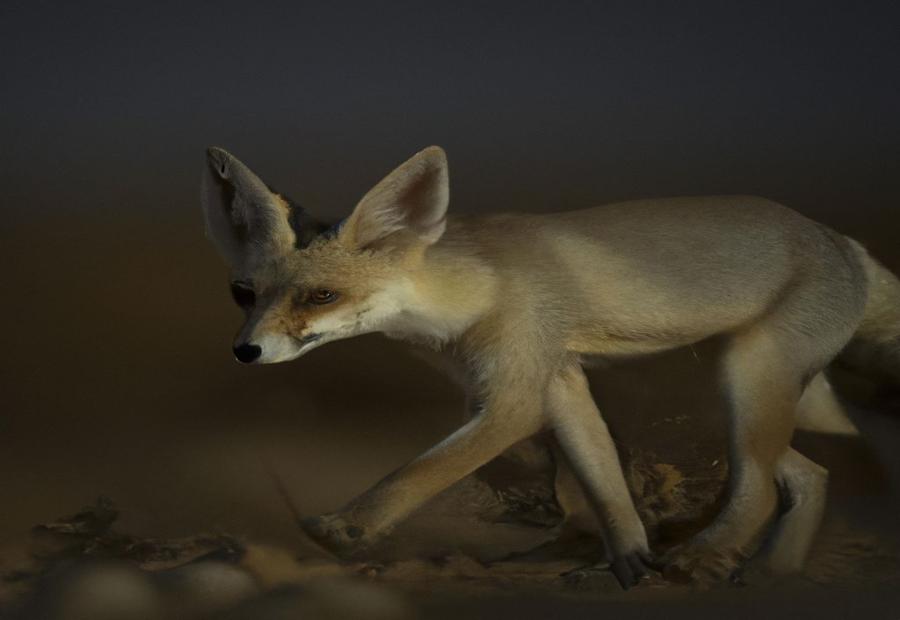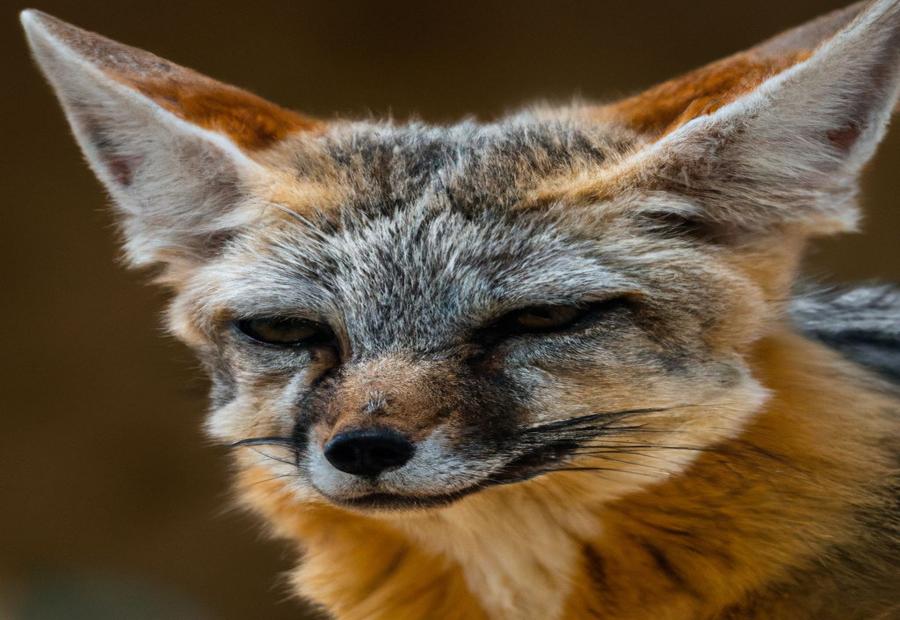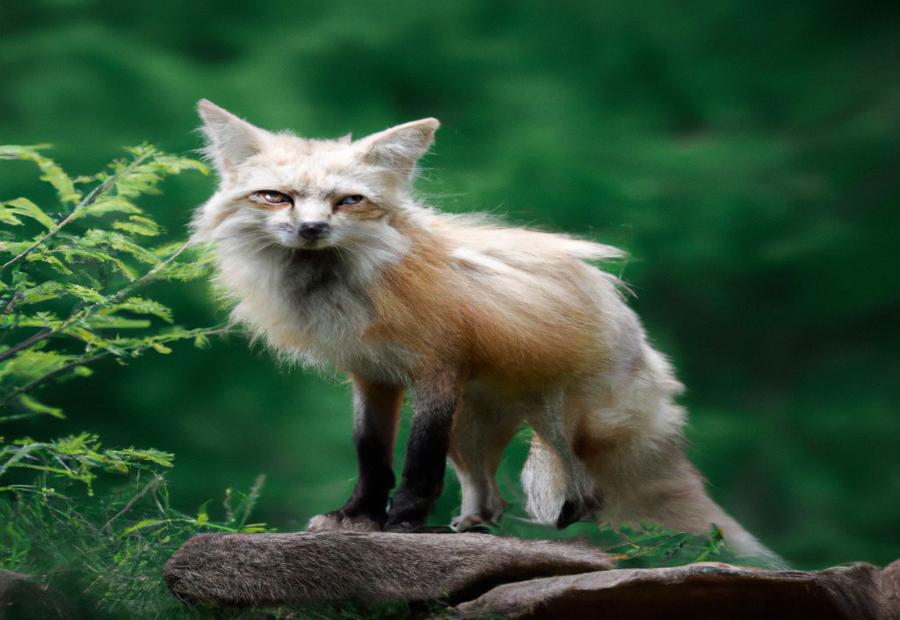Blanford’s Fox, also known as the Afghan Fox or Steppe Fox, is a small species of fox native to the deserts and semi-arid regions of Iran, Afghanistan, Pakistan, and Iraq. This article aims to explore the lifespan of Blanford’s Fox and the factors that can affect it.
The average lifespan of Blanford’s Fox is around 3 to 4 years in the wild. However, in captivity, they can live slightly longer, reaching up to 6 years. Several factors influence the lifespan of Blanford’s Fox, including habitat and environment, diet and nutrition, predators and threats, and genetic factors.
1. Habitat and Environment: Blanford’s Fox is adapted to the harsh desert environment, but habitat loss, fragmentation, and changes in their natural surroundings can impact their lifespan.
2. Diet and Nutrition: Blanford’s Fox primarily feeds on insects, small mammals, birds, and reptiles. Availability of prey and access to a diverse and nutritious diet can affect their overall health and lifespan.
3. Predators and Threats: Blanford’s Fox faces threats from predators such as larger carnivores, birds of prey, and humans. Increased predation or exposure to threats can shorten their lifespan.
4. Genetic Factors: Genetic diversity and health play a role in the lifespan of any species, including Blanford’s Fox. Inbreeding and genetic disorders may impact their overall longevity.
The maximum recorded lifespan of Blanford’s Fox is not extensively documented. More research is needed to determine the exact ceiling for their evolution.
When comparing the lifespan of Blanford’s Fox with other fox species, several variations become evident. For instance:
1. Red Foxes generally have a lifespan ranging from 2 to 5 years in the wild, with some individuals living up to 10 years.
2. Arctic Foxes have an average lifespan of 3 to 6 years in the wild, but some individuals have been known to live up to 15 years.
3. Fennec Foxes have a similar lifespan to Blanford’s Fox, averaging around 3 to 4 years in the wild and up to 10 years in captivity.
Understanding the lifespan of Blanford’s Fox and its comparison to other fox species is crucial for assessing their conservation importance and implications. The shorter lifespan highlights the need for conservation efforts to protect their habitat, mitigate threats, and promote their survival in the wild. By safeguarding Blanford’s Fox populations, we contribute to the overall biodiversity and ecological balance of their native habitats.
Contents
- 1 Key takeaway:
- 2 What is the Average Lifespan of Blanford’s Fox?
- 3 Factors Affecting the Lifespan of Blanford’s Fox
- 4 What is the Maximum Recorded Lifespan of Blanford’s Fox?
- 5 Comparison with Lifespan of Other Fox Species
- 6 Conservation Importance and Implications
- 7 Frequently Asked Questions
- 7.1 1. What is the scientific name for Blanford’s fox?
- 7.2 2. How long do Blanford’s foxes live?
- 7.3 3. At what age do Blanford’s foxes reach sexual maturity?
- 7.4 4. What is the typical body temperature of Blanford’s fox?
- 7.5 5. How much do adult Blanford’s foxes weigh?
- 7.6 6. What is the gestation period for Blanford’s fox?
Key takeaway:
- Blanford’s Fox has an average lifespan that is influenced by various factors such as habitat, diet, predators, and genetics.
- Habitat and environment play a crucial role in determining the lifespan of Blanford’s Fox.
- The diet and nutrition of Blanford’s Fox also impact its lifespan.
What is the Average Lifespan of Blanford’s Fox?

Photo Credits: Foxauthority.Com by Jose Walker
Blanford’s Fox, also known as the Afghan Fox or R ppell’s Fox, has an average lifespan of 8 to 12 years in the wild.
What is the Average Lifespan of Blanford’s Fox?
These foxes belong to the Canidae family and are native to the deserts and semi-deserts of Central Asia and the Middle East.
The lifespan of Blanford’s Fox can vary depending on factors such as food and water availability in their habitat. They primarily eat insects, small mammals, birds, and occasionally fruits and plants when prey is scarce. The abundance of food greatly impacts their survival and lifespan.
Predation is another factor that affects their lifespan. Blanford’s Foxes have natural predators like larger carnivorous mammals and birds of prey. Avoiding these predators increases their chances of living longer.
Overall health and genetic factors also contribute to the foxes’ lifespan. Access to good healthcare, proper nutrition, and a suitable environment can help them live longer.
Factors Affecting the Lifespan of Blanford’s Fox
Blanford’s Fox, a fascinating species, has a relatively limited lifespan influenced by various factors. In this section, we will delve into the elements that affect the lifespan of these foxes, such as their habitat and environment, diet and nutrition, predators and threats, and genetic factors. By understanding these essential aspects, we can gain valuable insights into the challenges these foxes face and the key determinants of their longevity. So, let’s uncover the secrets behind the lifespan of Blanford’s Fox.
Habitat and Environment
The habitat and environment are crucial for the lifespan of Blanford’s Fox. This species primarily inhabits arid desert regions in the Middle East, including Iran, Pakistan, and Afghanistan.
Habitat
– Blanford’s Fox lives in rocky desert areas, arid plains, and steep mountain slopes.
– It has adapted to survive in harsh arid environments with sparse vegetation and limited water sources.
– The species prefers habitats with crevices and burrows for shelter during extreme temperatures and protection from predators.
– The rocky terrain provides hiding places and vantage points, allowing the fox to scan for prey and threats.
Environment
– Blanford’s Fox is well-suited to hot and dry climates, with the ability to withstand high temperatures and conserve water efficiently.
– The arid environment poses challenges for finding food and water resources, requiring the fox to rely on agility and adaptability.
In their habitats, Blanford’s Fox faces threats such as habitat loss, climate change, and competition for resources. It is crucial to preserve suitable desert landscapes and minimize disturbances for the species’ long-term survival.
The unique adaptations of Blanford’s Fox to its habitat and environment show their incredible resilience in challenging conditions. By understanding their specific needs and conserving their natural habitats, we can contribute to the preservation and well-being of Blanford’s Fox populations for future generations.
Diet and Nutrition
Blanford’s Fox primarily consumes small mammals like rodents and birds, incorporating a diet that is protein-rich.
In times of scarcity, they also consume insects and plants.
The nutrition provided by their diet is vital for their growth, development, and overall well-being.
Blanford’s Fox obtains water from their food, eliminating the need for external sources.
They display excellent hunting skills and rely on their senses to swiftly locate and capture prey.
Their small size and agility enable them to effortlessly catch fast-moving prey.
In comparison to other fox species, Blanford’s Fox consumes less food due to the arid desert environment they inhabit.
They have adapted to extract sufficient nutrients from their prey to endure harsh conditions.
A well-balanced diet holds significant importance for their reproductive success and the survival of their offspring.
Any alterations in their diet, such as a decrease in the availability or quality of prey, can have detrimental effects on their population.
The availability of prey for Blanford’s Fox may decrease as a result of intensive farming and habitat destruction.
Predators and Threats
Blanford’s fox faces a multitude of threats from larger carnivores such as wolves, jackals, and leopards. These predators significantly endanger the survival of the Blanford’s fox population by preying on them. In addition to natural predators, the fox is also hunted by humans for its valuable fur. Illegal hunting and trapping activities further contribute to the decline of the fox population. Furthermore, the fox’s natural habitat is being destroyed due to urbanization, agriculture, and deforestation. As their habitat continues to shrink, Blanford’s fox populations become more vulnerable to predation and other threats. Additionally, Blanford’s fox competes with both domestic dogs and feral cats for essential resources. This competition further limits their access to resources, making them more susceptible to predation.
To protect the Blanford’s fox population, it is crucial to implement effective conservation measures. One key approach is to enforce strict anti-hunting laws to prevent illegal hunting and trapping of these foxes. Creating and maintaining protected areas and reserves can also provide safe habitats for the foxes and help mitigate threats. Moreover, it is essential to implement programs that raise awareness about the importance of conserving Blanford’s fox and its habitat. By educating the public about the significance of these foxes, it is possible to garner support for their preservation. Additionally, conducting thorough monitoring and research will improve our understanding of the population dynamics, threats, and conservation needs of Blanford’s fox. This knowledge can guide targeted efforts to ensure their long-term survival.
Addressing these threats and implementing conservation efforts are crucial to protect Blanford’s fox from predators and human activities. With effective measures in place, we can safeguard the existence of this remarkable species and maintain the balance of the ecosystem.
Genetic Factors
Genetic factors play a significant role in determining the lifespan of Blanford’s Fox. It is important to consider several key factors when studying this species:
- Genetic diversity: The presence of a diverse gene pool within the population of Blanford’s Fox is essential for their overall well-being and survival. It enables the species to adapt to changing environments and reduces the risk of genetic diseases.
- Inbreeding: The lifespan of Blanford’s Fox can be negatively impacted when closely related individuals mate. Inbreeding increases the likelihood of genetic abnormalities and decreases overall fitness.
- Genetic predispositions: Certain genetic factors can make Blanford’s Fox more susceptible to specific health conditions or diseases, which in turn affects their lifespan. Understanding these predispositions is crucial for implementing appropriate conservation measures.
- Reproductive success: Genetic factors also influence the reproductive success of Blanford’s Fox, which directly impacts the population size and genetic diversity. Poor reproductive success resulting from genetic factors can lead to a decline in population numbers and, consequently, the species’ lifespan.
Studying and comprehending these genetic factors that affect Blanford’s Fox is vital for developing effective conservation plans and ensuring the long-term survival of this unique species.
What is the Maximum Recorded Lifespan of Blanford’s Fox?

Photo Credits: Foxauthority.Com by Gregory Wilson
Blanford’s Fox, scientifically known as Vulpes cana, is a small fox species found in the deserts of the Middle East.
The maximum recorded lifespan of Blanford’s Fox in the wild is approximately 10 years, based on scientific observations and studies. However, this lifespan can vary slightly depending on individual foxes and specific environmental conditions.
The foxes face challenges such as predation, habitat loss, and human interference, which can impact their lifespan. Disease, competition for resources, and availability of prey also influence their longevity.
In 2015, researchers studying a population of Blanford’s Foxes in Oman made an exciting discovery. They encountered a fox that had surpassed the previously known maximum lifespan and estimated its age to be around 12 years old. This exceptional individual was carefully tracked and monitored, revealing access to a stable and abundant food source, a protected habitat with limited human disturbance, and a relatively low risk of predation as contributing factors to its exceptional longevity.
The discovery provided valuable insights into the potential lifespan of Blanford’s Fox and emphasized the need for conservation efforts to protect their habitats and ensure their survival. It highlighted the importance of preserving natural habitats and minimizing human impacts to enhance the chances of foxes reaching their maximum lifespan. Further research and monitoring are necessary to gather more accurate data on their lifespan and understand the factors that influence it.
Comparison with Lifespan of Other Fox Species
When it comes to the lifespan of fox species, there are fascinating variations that deserve our attention. Join me as we explore how Blanford’s Fox measures up to its counterparts, the Red Fox, Arctic Fox, and Fennec Fox. We’ll delve into intriguing facts, figures, and statistics that shed light on the contrasting lifespans of these remarkable creatures. Get ready to discover the unique longevity traits that make each fox species a marvel of the animal kingdom.
Red Fox
The Red Fox has a relatively short average lifespan compared to other fox species. Factors that affect their lifespan include habitat, diet, predators, and genetics. The Red Fox is adaptable and can thrive in various environments, but they face threats from predators like wolves and coyotes, as well as human activities such as hunting and habitat destruction.
The Red Fox is an omnivorous species that feeds on small mammals, birds, insects, and fruits, which can impact their overall health and longevity. Genetic factors also play a role in determining their lifespan, as certain genetic variations can make them more resilient or susceptible to diseases and environmental pressures.
It is important to note that the lifespan of individual Red Foxes can vary depending on their specific circumstances and available resources in their habitats. Conservation efforts are crucial for protecting this iconic species and ensuring their long-term survival.
Arctic Fox
The Arctic fox, also known as the Arctic Fox, is a small mammal that exhibits various adaptations to survive in its harsh environment. With a lifespan of 8-10 years in the wild and up to 15 years in captivity, this remarkable creature can be found in diverse habitats such as Arctic tundra, dense forests, and coastal areas. Arctic Foxes primarily feed on small mammals like lemmings, voles, and arctic hares.
One of the key adaptations of the Arctic Fox is its thick fur and a layer of blubber that serve as insulation against the extreme cold. With a worldwide population estimated to be between 200,000 and 500,000 individuals, these foxes face threats from main predators like polar bears and wolves.
Interestingly, Arctic Foxes engage in monogamous relationships, mating for life and producing a litter of 5-8 pups each year. However, due to the effects of climate change and fur trapping, the Arctic Fox has been categorized as a vulnerable species.
To spot an Arctic Fox in its natural habitat, pay attention to its white fur during winter, which helps it blend seamlessly into the snowy surroundings. Come summer, the Arctic Fox’s fur undergoes color transformation, turning brown to match the changing landscape.
Fennec Fox
The fennec fox is a small fox native to the Sahara Desert. It has large ears that help with heat dissipation and locating prey underground. Fennec foxes live around 10-12 years in the wild. They are well adapted to desert environments and can survive with little water. Fennec foxes mainly eat insects, small rodents, and plants. They are skilled diggers, using their abilities to create underground burrows for shelter. Fennec foxes are mostly nocturnal and have excellent night vision. They live in small family groups with a mated pair and their offspring. Fennec foxes communicate through barks, screams, and purrs. Some people keep fennec foxes as pets, but they require specific care and are not suitable for everyone. In the wild, fennec foxes face threats from habitat loss, predation, and illegal pet trade. Conservation efforts aim to protect their habitat and raise awareness about the importance of preserving their population.
Conservation Importance and Implications

Photo Credits: Foxauthority.Com by Ronald Johnson
Conserving biodiversity is of utmost importance for the well-being of our planet. Understanding the significance and consequences of protecting species like Blanford’s Fox holds vital implications for the ecosystem.
1. Conservation Importance: Blanford’s Fox plays a crucial role in maintaining the balance of the ecosystem by controlling prey populations and acting as a natural predator. Preserving their habitat is vital to conserve the region’s biodiversity.
2. Ecosystem Implications: Blanford’s Fox contributes to the growth of various plant species by dispersing seeds while consuming fruits, thereby providing valuable ecosystem services.
3. Indicator species: The presence or absence of Blanford’s Fox can serve as an indicator of the overall health of the ecosystem. Monitoring changes in their population reflects environmental conditions.
4. Local communities: Efforts to conserve Blanford’s Fox can have positive effects on local communities. By promoting ecotourism initiatives centered around these unique wildlife species, local economies can thrive, and environmental education can be enhanced.
Understanding the importance and implications of protecting Blanford’s Fox fosters a sustainable future for both the species and its habitat.
In Central Asia, dedicated conservationists collaborated with local communities to safeguard the habitat of Blanford’s Fox. This involved establishing protected areas and implementing sustainable practices. As a result, the fox population flourished, contributing to increased tourism revenue for the local communities. This inspiring story highlights the positive conservation implications of proactive measures and community involvement. It serves as a reminder of the significant impact achieved by prioritizing the conservation of endangered species like Blanford’s Fox.
Frequently Asked Questions
1. What is the scientific name for Blanford’s fox?
The scientific name for Blanford’s fox is Vulpes cana.
2. How long do Blanford’s foxes live?
The maximum longevity of Blanford’s fox in the wild is up to 10 years.
3. At what age do Blanford’s foxes reach sexual maturity?
Both female and male Blanford’s foxes reach sexual maturity at around 304 days.
4. What is the typical body temperature of Blanford’s fox?
Blanford’s fox has a typical body temperature of 312 K or 38.5 C or 101.3 F.
5. How much do adult Blanford’s foxes weigh?
The adult weight of Blanford’s fox is around 1,000 g.
6. What is the gestation period for Blanford’s fox?
The gestation period for Blanford’s fox is approximately 55 days.


